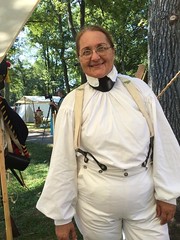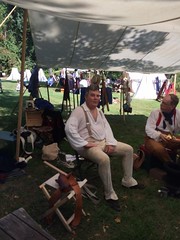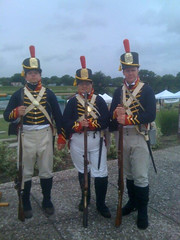A Brief History
When war began in 1812 the Marine Corps was only fifteen years old. Marines had served during the American Revolution, but the units raised during that conflict had been disbanded in 1783. During the troubled 1790s it had become necessary to organize a small frigate navy with a tiny marine corps to protect the growing merchant fleet of the United States. These "soldiers of the sea" were under the Secretary of the Navy. When serving as part of land forces, however, they came under the authority of the superior army officers. Marines, then as now, considered themselves the elite of American fighting men and sometimes had to be reminded that they should obey army and not navy officers in these circumstances.
As with the rest of the regular forces, the authorized establishment of the marine corps far exceeded the actual numbers in service. Fortunately, the figures for "active duty strength" are known for the War of 1812.
June 30, 1812 Ten officers, 484 enlisted men.
June 30, 1813 Twelve officers 579 enlisted men.
June 30, 1814 Eleven officers 579 enlisted men.
June 30, 1815 Eight officers 680 enlisted men.
Marine’s services was highly varied and as a rule, the corps was scattered in small detachments aboard naval vessels. Other detachments however, were stationed in Louisiana, Washington, Philadelphia, and on the Great Lakes. Small detachments participated in many minor actions.
In the north, there were three officers and 121 marines on Lake Ontario, and detachments from this force participated in the capture of York, Upper Canada and Ft. George and the defense of Sackets Harbor. A detachment was attached to Scott's brigade on the Niagara in 1814. The Washington detachment, totaling a little over 100 men, fought gallantly at Bladensburg August 24, 1814. A small marine detachment was present at the defense of Ft. McHenry on September 11-13, 1814. In New Orleans, another detachment of marines under Major Daniel Carmick participated in the night action December 23, 1814 during the defense of that city against the British.
In all the land actions in which they participated during the War of 1812, the Marine Corps fought hard and, at Bladensburg and New Orleans, with distinction. Because of its small size, the Marine Corps did not play a major role in the war on land, but the regular army must have appreciated the existence of this reliable regular force.
1812 Marine Uniform
Marine Privates had a dark blue single-breasted coatee with red collar, cuff and turnbacks on the short skirts. Buttons were brass, and the lace was yellow, ending in a point and set in a "V". White cloth pantaloons with black cloth gaiters "to the knee" were worn in the winter and line overalls in the summer. The felt Shako (cap) had a brass plate, red plush plume in the front, yellow cords, and tassels. A black stock completed the uniform.
Sergeants wore a red feather plume on the left side (instead of the front) of the their caps and had a brass-hilted straight sword but no sash.
Drummers wore a "reversed" colors which gave them red coatees with blue collar, cuff and turnbacks. An 1814 order for drums mentions eagles painted on canvas with a "Scrowl over the head or from its beak with the Motto, "United States Marines" above. The rest of the clothing was probably the same as for the privates.
Summer dress as worn from the beginning of June until October. This included white line pantaloons but apparently not a line jacket at the time of the war.
Arms and Accoutrements
Non-commissioned officers and enlisted men carried a musket and bayonet. The muskets might have been the French "light 1763", the U.S. Model 1795 or even the British India Pattern. Cross belts were white, and there is no evidence that black belts were used by Marines during the War of 1812. The oval belt plate were of brass. Cartridge boxes (1808) were black leather, probably of the same pattern as for the army.






